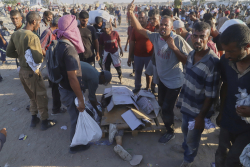The Kremlin had initiated the Armata program in 2011, and the prototype T-14 was unveiled at the 2015 Victory Day Parade in Moscow.
Russia’s United Aircraft Corporation (UAC) has repeatedly sought to close a deal that would see India co-produce the fifth-generation Sukhoi Su-57 (NATO reporting name “Felon”) stealth fighter. Although New Delhi has not made any announcement, there are reasons to believe that India will opt for the Russian multirole fighter. However, it may not be the only advanced Russian system that could be manufactured under license in the sub-continent.
Indian media reported earlier this week that the Kremlin has offered its long-touted T-14 Armata main battle tank (MBT) to New Delhi to replace its fleet of aging T-72 Ajeya tanks. Beyond just selling new tanks, Moscow has included an option that would see the T-14s manufactured under license as part of the “Make in India” program.
Moreover, the Russian state-owned Uralvagonzavod, which produces the T-14, has signaled that it would allow India to adapt the tank to meet the local requirements. Moscow is even willing to allow for the integration of the domestically-produced DATRAN-1500HP engine rather than the Russian-made 12N360 to be employed in the Indian-made Armata MBTs. India’s Combat Vehicles Research and Development Establishment (CVRDE) has been named as one of the entities that could be on board to co-produce the tank.
Under such a partnership, the Indian government would provide up to 70 percent of the funding to develop the first prototype.
Who Benefits More from the Deal: India or Russia?
The Kremlin had initiated the Armata program in 2011, and the prototype T-14 was unveiled at the 2015 Victory Day Parade in Moscow. However, in a portent of the trials and tribulations that the program would face, the prototype suffered a mechanical breakdown during the parade rehearsal. Despite the embarrassing introduction, the Kremlin had announced plans to build 2,300 T-14s by 2020, with the 1st Guards Tank Army (GTA) to receive the new platform.
Fast forward a decade later, and Russia had scaled back the order considerably. Instead of the thousands of Armatas, it was subsequently announced that a test block of 100 would be manufactured for the 2nd Guards Tamanskaya Motor Rifle Division. Still, production has fallen short of even that truncated number.
As of August 2025, it is believed that fewer than two dozen T-14s have rolled off the assembly line. Budget constraints were one factor, while the sanctions imposed on Russia after it launched its invasion of Ukraine further derailed the program.
The T-14 could now score its biggest win if India opts to adopt it, significantly bolstering the program by reducing costs.
“Each T-14 unit is projected to cost roughly $3.4–4.8 million, but local manufacturing in India could slash that by at least $1.14 million,” Ukraine’s United24 Media reported.
If India and Russia could strike a deal for the co-production of the T-14, such an agreement would not be the first. Uralvagonzavod already has a technology transfer agreement in place with New Delhi for its T-90 MBT, which is manufactured domestically in India as the T-90 Bhishma. That tank employs as much as 83 percent indigenous technology, including a locally-made engine.
Why India May Not Roll Forward with the T-14
Russia and India have yet to strike a deal, and one may never materialize. Cost remains a critical issue. The T-14 is a very expensive tank, and even if India can bring the price down, it may be more costly than New Delhi is willing to spend on an unproven platform.
The T-14’s lack of use in combat and its vulnerability to emerging threats, including drones, are significant unknowns. Will India want to produce hundreds or even thousands of T-14s and then find that low-cost Pakistani or Chinese drones and man-portable anti-tank rocket launchers are capable of destroying the tank all too easily in a border flare-up?
It is simply a matter of when, not if, such an engagement occurs, and India is still reeling after one of its French-made Dassault Rafale fighters was shot down by a Chinese-made missile fired by a Pakistani fighter jet. New Delhi believed the hype about the Rafale and learned a costly and embarrassing lesson; it may not want to do the same with the T-14.
About the Author: Peter Suciu
Peter Suciu has contributed over 3,200 published pieces to more than four dozen magazines and websites over a thirty-year career in journalism. He regularly writes about military hardware, firearms history, cybersecurity, politics, and international affairs. Peter is also a Contributing Writer for Forbes and Clearance Jobs. He is based in Michigan. You can follow him on Twitter: @PeterSuciu. You can email the author: [email protected].
Image: Shutterstock / Oleg Elkov.
















